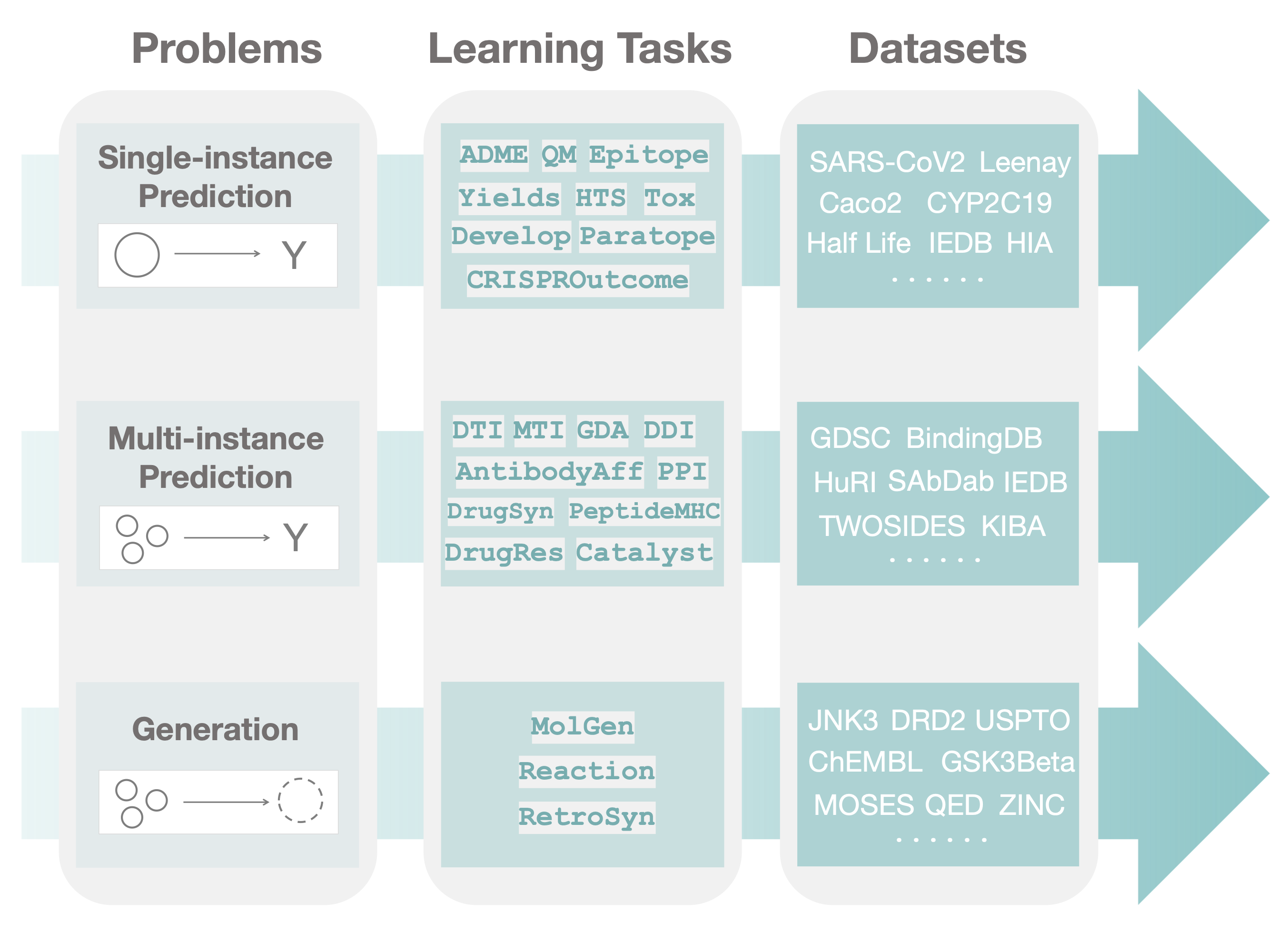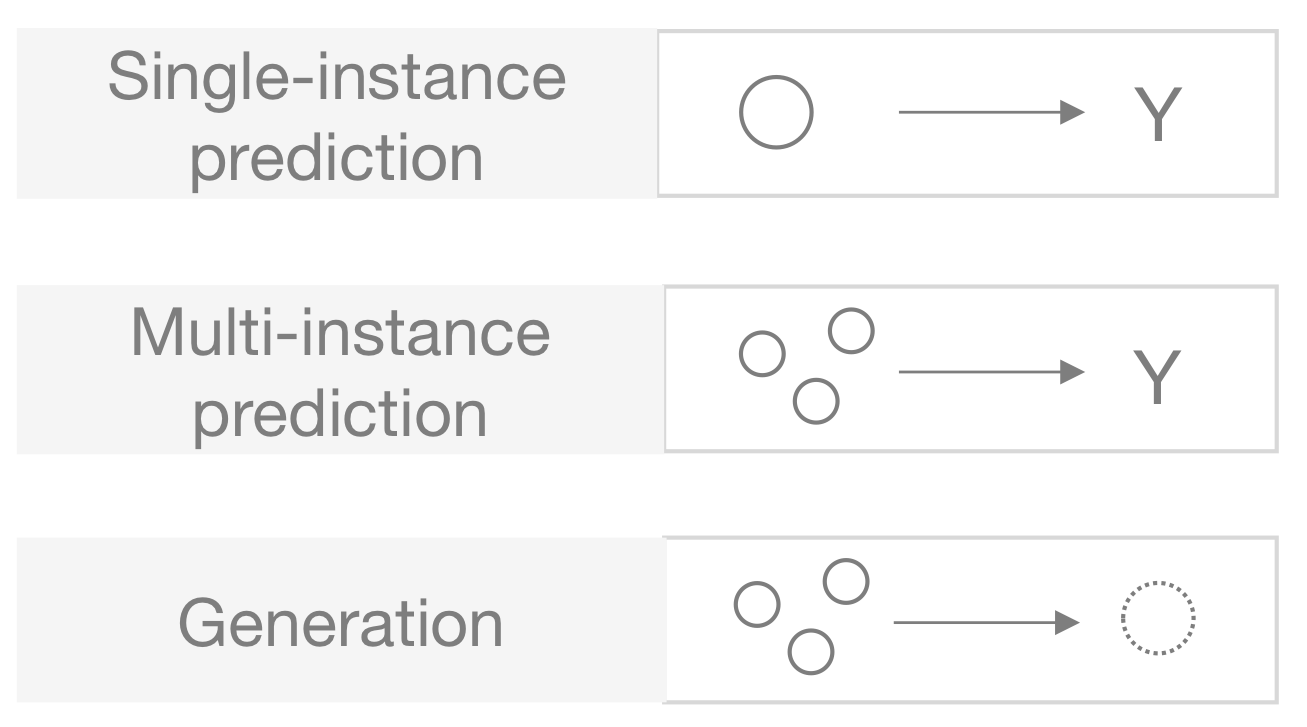Therapeutics Data Commons (TDC) is a collection of machine learning tasks spread across different domains of therapeutics.
Therapeutics machine learning is an exciting field with incredible opportunities for expansion, innovation, and impact. Datasets and benchmarks in TDC provide a systematic model development and evaluation framework that allows more machine learning researchers to contribute to the field.
We envision that TDC can considerably accelerate machine-learning model development, validation and transition into production and clinical implementation.
Invited talk at the Harvard Symposium on Drugs for Future Pandemics (#futuretx20) [Slides] [Video]
0.1.3: Added new therapeutics task on CRISPR Repair Outcome Prediction! Added a data function to map molecule to popular cheminformatics fingerprint.0.1.2: The first TDC Leaderboard is released! Checkout the leaderboard guide here and the ADMET Leaderboard here.0.1.1: Replaced VD, Half Life and Clearance datasets from new sources that have higher qualities. Added LD50 to Tox.0.1.0: Molecule quality check for ADME, Toxicity and HTS (canonicalized, and remove error mols).0.0.9: Added DrugComb NCI-60, CYP2C9/2D6/3A4 substrates, Carcinogens toxicity!0.0.8: Added hREG, DILI, Skin Reaction, Ames Mutagenicity, PPBR from AstraZeneca; added meta oracles!
- Diverse areas of therapeutics development: TDC covers a wide range of learning tasks, including target discovery, activity screening, efficacy, safety, and manufacturing across biomedical products, including small molecules, antibodies, and vaccines.
- Ready-to-use datasets: TDC is minimally dependent on external packages. Any TDC dataset can be retrieved using only 3 lines of code.
- Data functions: TDC provides extensive data functions, including data evaluators, meaningful data splits, data processors, and molecule generation oracles.
- Leaderboards: TDC provides benchmarks for fair model comparison and a systematic model development and evaluation.
- Open-source initiative: TDC is an open-source initiative. If you want to get involved, let us know.
To install the core environment dependencies of TDC, use pip:
pip install PyTDCNote: TDC is in the beta release. Please update your local copy regularly by
pip install PyTDC --upgradeThe core data loaders are lightweight with minimum dependency on external packages:
numpy, pandas, tqdm, scikit-learn, fuzzywuzzyFor utilities requiring extra dependencies, TDC prints installation instructions. To install full dependencies, please use the following conda-forge solution.
Data functions for molecule oracles, scaffold split, etc., require certain packages like RDKit. To install those packages, use the following conda installation:
conda install -c conda-forge pytdcIf you found our work useful, please cite us:
@misc{tdc,
author={Huang, Kexin and Fu, Tianfan and Gao, Wenhao and Zhao, Yue and Roohani, Yusuf and Leskovec, Jure and Coley, Connor and Xiao, Cao and Sun, Jimeng and Zitnik, Marinka},
title={Therapeutics Data Commons: Machine Learning Datasets for Therapeutics},
howpublished={\url{https://zitniklab.hms.harvard.edu/TDC/}},
month=nov,
year=2020
}
We are now preparing a manuscript, which we will release soon.
TDC has a unique three-layer hierarchical structure, which to our knowledge is the first attempt at systematically evaluating machine learning across the field of therapeutics. We organize TDC into three distinct problems, each of these problems is instantiated through a variety of learning tasks, and each task, in turn, is evaluated on a series of datasets.
We choose our datasets to highlight three major areas (problems) where machine learning can facilitate scientific advances: single-instance prediction, multi-instance prediction, and generative modeling:
- Single-instance prediction
single_pred: Prediction of property given individual biomedical entity. - Multi-instance prediction
multi_pred: Prediction of property given multiple biomedical entities. - Generation
generation: Generation of a new biomedical entity.
The second layer in the TDC structure is organized into learning tasks. Improvement on these tasks range in applications, including designing new antibodies, identifying personalized combinatorial therapies, improving disease diagnosis, and finding new cures for emerging diseases.
Finally, in the third layer of TDC, each task is instantiated via multiple datasets. For each dataset, we construct data splits to simulate biomedically relevant generalizations, such as a model's ability to generalize to entirely unseen compounds, or to granularly resolve patient response to a polytherapy.
Each machine learning problem comprises of multiple learning tasks. TDC provides a data loader class for each task inheriting from the base data loader.
Each learning task is instantiated through many datasets. Most datasets for a given task have the same structure. To get a dataset, use the dataset_name as a function input to the task data loader.
Suppose you want to retrieve dataset X to study therapeutics task Y which falls under the problem Z. To obtain the dataset and its associated data split, use the following:
from tdc.Z import Y
data = Y(name = 'X')
splits = data.split()For example, to obtain the HIA dataset from ADME therapeutic task in the single-instance prediction problem:
from tdc.single_pred import ADME
data = ADME(name = 'HIA_Hou')
# split into train/val/test using benchmark seed and split methods
split = data.get_split(method = 'scaffold', seed = 'benchmark')
# get the entire data in the various formats
data.get_data(format = 'df')You can see all the datasets belonging to a task via:
from tdc.utils import retrieve_dataset_names
retrieve_dataset_names('ADME')See all therapeutic tasks and datasets on the TDC website!
To retrieve the training/validation/test dataset split, you could simply type
data = X(name = Y)
data.get_split(seed = 42)
# {'train': df_train, 'val': df_val, ''test': df_test}You can specify the splitting method, random seed, and split fractions in the function by e.g. data.get_split(method = 'scaffold', seed = 1, frac = [0.7, 0.1, 0.2]). Check out the data split page on the website for details.
We provide various evaluation metrics for the tasks in TDC, which are described in model evaluation page on the website. For example, to use metric ROC-AUC, you could simply type
from tdc import Evaluator
evaluator = Evaluator(name = 'ROC-AUC')
score = evaluator(y_true, y_pred)We provide numerous data processing helper functions such as label transformation, data balancing, pair data to PyG/DGL graphs, negative sampling, database querying and so on. For individual function usage, please checkout the data processing page on the website.
For molecule generation tasks, we provide 10+ oracles for both goal-oriented and distribution learning. For detailed usage of each oracle, please checkout the oracle page on the website. For example, we want to retrieve the GSK3Beta oracle:
from tdc import Oracle
oracle = Oracle(name = 'GSK3B')
oracle(['CC(C)(C)....'
'C[C@@H]1....',
'CCNC(=O)....',
'C[C@@H]1....'])
# [0.03, 0.02, 0.0, 0.1]Note that the graph-to-graph paired molecule generation is provided as separate datasets.
TDC hosts a series of leaderboards for researchers to keep abreast with the state-of-the-art models on therapeutics tasks.
Each dataset in TDC is a benchmark. But for a machine learning model to be useful for a specific downstream therapeutic usage, the model has to achieve consistently good performance across a set of datasets or tasks. Motivated by this, TDC intentionally group individual benchmarks into a benchmark group. Datasets in a benchmark group are centered around a theme and are all carefully selected. The dataset split and evaluation metrics are also carefully selected to reflect real-world challenges.
TDC provides a programming framework to access the data in a benchmark group. We use ADMET group as an example.
from tdc import BenchmarkGroup
group = BenchmarkGroup(name = 'ADMET_Group', path = 'data/')
predictions = {}
for benchmark in group:
name = benchmark['name']
train, valid, test = benchmark['train'], benchmark['valid'], benchmark['test']
## --- train your model --- ##
predictions[name] = y_pred
group.evaluate(predictions)
# {'caco2_wang': {'mae': 0.234}, 'hia_hou': {'roc-auc': 0.786}, ...}For more functions of the BenchmarkGroup class, please visit here.
We provide a series of tutorials for you to get started using TDC:
| Name | Description |
|---|---|
| 101 | Introduce TDC Data Loaders |
| 102 | Introduce TDC Data Functions |
| 103.1 | Walk through TDC Small Molecule Datasets |
| 103.2 | Walk through TDC Biologics Datasets |
| 104 | Generate 21 ADME ML Predictors with 15 Lines of Code |
| 105 | Molecule Generation Oracles |
TDC is designed to be a community-driven effort. If you have new dataset or task or data function that wants to be included in TDC, please fill in this form!
Send emails to us or open an issue.
TDC is hosted in Harvard Dataverse. When dataverse is under maintenance, TDC will not able to retrieve datasets. Although rare, when it happens, please come back in couple of hours or check the status by visiting the dataverse website.
TDC codebase is under MIT license. For individual dataset usage, please refer to the dataset license in the website.





